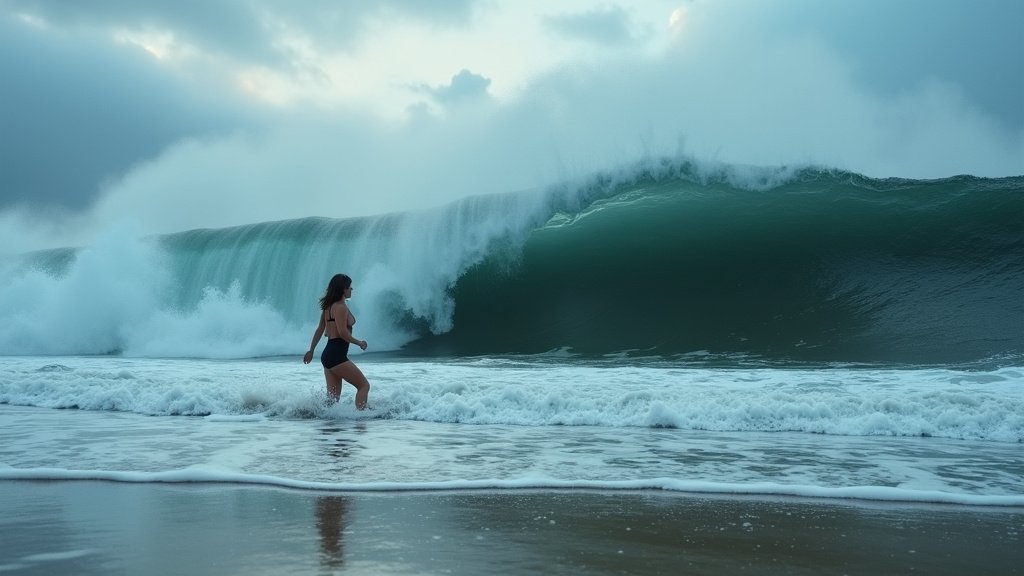Oregon Coast Tragedy Underscores Dangers of Sneaker Waves: Safety Remains Paramount
A recent fatality along the Oregon Coast has once again highlighted the unpredictable and deadly nature of sneaker waves, prompting urgent calls for increased public awareness and stringent safety measures. Caroline Moses, a 43-year-old woman from Corvallis, Oregon, was swept out to sea by a rogue surge of water while walking on the beach near Siletz Bay on Sunday, October 19, 2025. Despite an extensive multi-agency search involving jet skis, lifeboats, a helicopter, and a drone, her body was tragically found several miles south of where she was last seen. This tragic event serves as a stark reminder of the significant sneaker waves Oregon can present.
This incident serves as a grim reminder of the significant risks posed by sneaker waves, particularly along the Pacific Northwest coast. Since 2012, over two dozen deaths have been attributed to these powerful and deceptive ocean phenomena on the West Coast. Oregon, with its dynamic and often rugged coastline, is particularly susceptible to these dangers, with an estimated two to four deaths occurring annually due to sneaker waves, especially during the winter months. Understanding sneaker waves Oregon is crucial for all visitors.
Understanding the Sneaker Wave Threat on the Oregon Coast
Sneaker waves, often described as “mini-tsunamis”, are not related to tsunamis caused by seismic events. Instead, they are characterized by disproportionately large coastal waves that appear suddenly and without warning, often after a period of smaller waves. These waves can surge much farther up the beach than expected, sometimes reaching up to 150 feet onto dry sand, and possess immense power. Their force is capable of knocking adults and children off their feet, lifting heavy driftwood logs, and even moving boulders. The sneaker wave danger is ever-present on the Oregon coast.
Scientists believe that sneaker waves form due to complex oceanographic conditions, including the constructive interference of multiple smaller waves piling up or energy transfers from distant storms. The unique geography of the Pacific Northwest coast, featuring mildly sloping beaches and a narrow continental shelf, can allow these waves to surge inland rather than dissipate like they might on the East Coast. While storms are often the ultimate cause, sneaker waves can manifest even on seemingly calm days, making them particularly treacherous. The Pacific Northwest coast demands respect for its ocean forces.
A Pattern of Tragedy and Warnings for Sneaker Waves Oregon
The recent fatality is not an isolated event. The National Weather Service (NWS) frequently issues “Beach Hazards Statements” for the Oregon Coast and surrounding areas, warning of increased risks from sneaker waves, especially during fall and winter months. These advisories are typically issued when conditions present “potentially life-threatening conditions in the surf zone”. Many are unaware of the sneaker wave danger until it’s too late.
In the days leading up to the incident, a Beach Hazards Statement was in effect from Friday, October 17, through Sunday, October 19, 2025, advising extreme caution along the North Oregon and South Washington Coasts. Despite these warnings, the unpredictable nature of sneaker waves means they can still catch even the most vigilant beachgoers by surprise. Proper ocean safety tips can save lives.
Heeding the Warnings: Safety Tips for Oregon Coast Visitors and Sneaker Waves Oregon
Coastal authorities and safety experts universally emphasize that vigilance and respect for the ocean are paramount when visiting the Oregon Coast. The National Weather Service and Oregon State Parks offer several crucial safety guidelines to help prevent further tragedies:
* Never Turn Your Back on the Ocean: This is the most critical piece of advice. Always maintain awareness of the waves and the water’s edge. If the sand is wet, the water has already reached that point. This is a key ocean safety tip for the Oregon Coast waves.
* Stay Far from the Water’s Edge: Maintain a significant distance from the surf zone, especially when sneaker waves are forecast. Waves can surge much farther inland than expected, even up to 150 feet. The sneaker wave danger is real and often underestimated.
* Observe Wave Patterns: Get a feel for the ocean’s behavior. Look for changes in wave patterns and be aware that conditions can change rapidly. If waves are spaced far apart (20 seconds or more) and look well-organized, a sneaker wave may be more likely to occur. Understanding oregon coast waves is vital.
* Heed Advisories and Forecasts: Always check local weather forecasts and NWS beach hazard statements before heading to the coast. These advisories highlight the deadly ocean waves that can appear unexpectedly.
* Avoid Risky Areas: Stay clear of rocks, jetties, and tide pools, particularly during high tide or when hazardous conditions are present. Be aware of driftwood logs, which can be extremely heavy and dangerous when moved by waves. The sneaker wave danger is amplified in these areas.
* Supervise Children and Pets: Keep a close eye on children and pets, ensuring they remain a safe distance from the water’s edge. These are simple but effective ocean safety tips.
* Do Not Enter Water to Rescue: If you witness someone being swept out to sea, do not go in after them. Immediately call 911 and provide rescuers with the location of the person from the shoreline. This is a critical ocean safety tip.
The allure of the Oregon Coast and its breathtaking natural beauty draws countless visitors seeking leisure and adventure. However, the powerful forces of the Pacific Ocean demand constant respect and caution. By understanding the dangers posed by sneaker waves and diligently following safety advice, beachgoers can significantly reduce their risk and ensure their coastal experiences are memorable for all the right reasons. The news of such incidents underscores that a day at the beach, while a cherished Oregon tradition, requires a commitment to safety above all else. The Pacific Northwest coast presents unique challenges for beachgoers due to the prevalence of sneaker waves Oregon.



